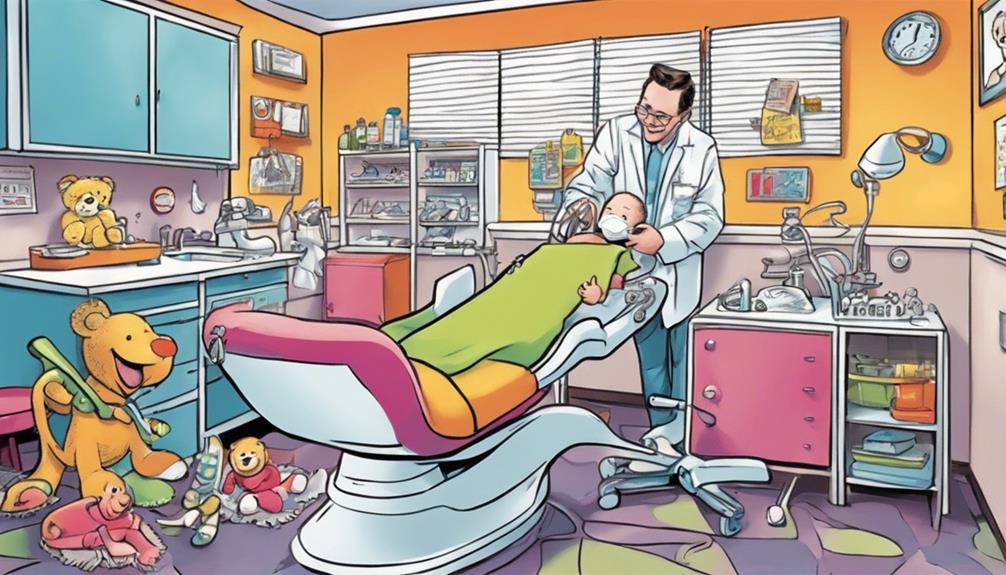Teething usually starts between 4 to 7 months, so don't be surprised if you notice some early signs around that time. Typically, the lower central incisors are the first teeth to appear, followed by the upper central incisors a few weeks later. By the time your baby is about 3 years old, they'll likely have all 20 primary teeth. You may see signs like drooling and irritability as these teeth come in. Keep an eye on your little one's symptoms, and find tips on soothing their discomfort that can help during this teething journey.
Key Takeaways
- Teething typically begins between 4 to 7 months, with the first teeth being lower central incisors.
- Lower central incisors usually erupt between 6 to 10 months, followed by upper central incisors around 8 to 12 months.
- Most children will have a full set of 20 primary teeth by age 3.
- Teething can start as early as 3 months or as late as 12 months.
Understanding Teething

Teething is a natural process that usually kicks off when your baby is between 4 to 7 months old, marking the exciting arrival of their first teeth. The first teeth to emerge are typically the lower central incisors, followed by the upper central incisors about 4 to 8 weeks later. As your baby's gums begin to swell, you might notice teething symptoms like drooling and irritability.
During these months, it's crucial to keep an eye on your baby's comfort. Some babies sail through teething with minimal fuss, while others may experience more discomfort. Swollen gums can make your little one cranky, leading to restless nights for both of you.
While most babies will have a complete set of 20 primary teeth by age 3, it's important to remember that every child is unique. If you notice unusual symptoms, such as a high fever or diarrhea, it mightn't be just teething.
Monitoring these signs can help you differentiate between standard teething symptoms and potential health issues, ensuring your baby stays healthy and happy during this milestone.
Teething Timeline

Tracking your baby's teething timeline can help you anticipate the arrival of their first teeth and manage any discomfort they might experience along the way. Generally, babies start teething around 6 months, but some might begin as early as 3 months or as late as 12 months. Here's a typical teething timeline to guide you:
- Lower Central Incisors: The first teeth to come are usually the two lower central incisors, which typically erupt between 6 to 10 months.
- Upper Central Incisors: Following the lower incisors, the upper central incisors emerge around 8 to 12 months, usually 4 to 8 weeks later.
- Other Primary Teeth: After the central incisors, expect additional primary teeth to begin coming in, with about four teeth erupting every six months.
- Complete Set of Primary Teeth: By age 3, your child will generally have a full set of 20 primary teeth.
Signs of Teething

As your baby approaches the teething stage, you'll likely notice several signs that indicate their teeth are on the way. One of the most common signs of teething is increased drooling, which often starts around 3 to 4 months of age.
You might also observe swollen gums where the teeth are pushing through, leading to irritability and fussiness as your little one experiences teething pain. Your baby may show a strong desire to chew on objects, fingers, or toys to relieve the discomfort of sore gums. This behavior is a natural response to the pressure of emerging teeth.
Changes in sleep patterns and decreased appetite can also occur during this time, as your baby may find it difficult to eat due to gum tenderness.
While some infants may develop mild fevers—typically below 102°F (38°C)—it's important to monitor for other symptoms like diarrhea, which could indicate a need for medical advice.
Soothing Teething Pain

When your baby's teething, finding ways to soothe their pain is essential.
You can try cold remedies, safe chewing alternatives, and consult your pediatrician for effective pain management strategies.
Let's explore these options to help your little one feel more comfortable.
Cold Remedies for Relief
Chilled teething rings and cold washcloths are effective ways to soothe your baby's teething pain. These remedies can provide soothing relief and help ease the discomfort your little one is experiencing. Here are some practical options to take into account:
- Chilled Teething Rings: Choose safe, solid teething rings, avoiding liquid-filled ones. The cold will help numb the gums.
- Cold Washcloth: Offer a clean, cold washcloth for your baby to chew on. The coldness can alleviate discomfort and provide some relief.
- Frozen Teething Toys: Briefly freeze teething toys to enhance their soothing effect, but make sure they're not too frozen to prevent gum injury.
- Natural Remedies: Small amounts of chamomile tea can offer calming effects, providing additional comfort during teething.
While these methods can be effective, always consult a pediatrician before administering any pain relief medications.
It's important to avoid over-the-counter gels containing benzocaine for infants under 2 years due to safety concerns.
Safe Chewing Alternatives
Safe chewing alternatives can effectively soothe your baby's teething pain while guaranteeing their safety during this challenging time.
Solid rubber teethers are a great option, providing a safe and durable way for your little one to relieve discomfort. Additionally, chilled teething rings can help numb sore gums, but make sure to avoid those filled with liquid, as they may break and pose a risk.
Another natural remedy is using frozen washcloths. Just wet a clean washcloth, freeze it for a short time, and let your baby gnaw on it to soothe their gums. Teething biscuits can also be offered, but you must supervise closely to prevent choking hazards.
Always remember to consult your pediatrician before introducing any new teething products or pain relief methods. They can help you guarantee that your chosen alternatives are safe and appropriate for your infant.
Pediatrician Pain Management Advice
Pediatricians often recommend gently massaging your baby's gums with a clean finger to help ease teething pain. This simple technique can provide immediate relief from teething discomfort.
In addition to gum massage, consider these effective strategies:
- Cold items: Use chilled teething rings or frozen washcloths to soothe gums. Just verify the items are safe and don't contain liquid that could break.
- Pain relief: If your infant seems inconsolable, pediatricians may suggest over-the-counter acetaminophen or ibuprofen. Always follow the dosage guidelines based on your child's age and weight.
- Avoid benzocaine: Stay away from teething gels with benzocaine for infants under 2 years, as they can pose safety risks and side effects.
- Regular check-ups: Schedule pediatric check-ups to monitor your baby's dental development and discuss any pain management needs.
Oral Hygiene for Infants

Establishing good oral hygiene for your infant is essential, and it starts even before the first tooth appears. You can begin by gently wiping your baby's gums with a soft cloth or gauze. This helps establish a routine and promotes healthy habits.
When your baby's first teeth emerge, typically around six months, start brushing them with a small, soft-bristled toothbrush and a smear of fluoride toothpaste.
As your child gets older, it's important to introduce flossing as soon as two teeth touch. This will help prevent cavities and maintain their oral health. You'll want to supervise this until your child is around 7 or 8 years old to verify they're doing it correctly.
Make it a habit to brush twice daily, especially after meals, to foster lifelong oral hygiene habits and prevent tooth decay.
Additionally, schedule a dental check-up by your child's first birthday or within six months of their first tooth appearing. This way, you can monitor their dental health and development, verifying their smiles stay bright and healthy as they grow.
Importance of Fluoride

Fluoride plays an essential role in preventing cavities and strengthening your baby's tooth enamel.
Starting around six months, you can introduce fluoride through sippy cups or straws, ensuring their teeth get the protection they need.
It's also wise to check with your pediatrician about fluoride varnish and supplements, especially if your child doesn't have access to fluoridated water.
Fluoride's Role in Prevention
Understanding the importance of fluoride in your child's dental care can greatly enhance their oral health and reduce the risk of cavities. Fluoride plays a vital role in strengthening teeth, making them more resistant to decay. Here are some key points to take into account:
- Fluoride Toothpaste: The American Dental Association recommends introducing fluoride toothpaste as soon as your child's first tooth erupts. Use a smear for infants and a pea-sized amount for kids over 3.
- Fluoride Varnish: Pediatricians suggest applying fluoride varnish when the first teeth appear, which can greatly lower the chance of cavities.
- Community Water: Many municipalities add fluoride to tap water, ensuring a consistent source of this essential mineral for growing children.
- Consult Your Pediatrician: If your child primarily drinks bottled water, check with your pediatrician about fluoride supplementation, as bottled water may lack adequate fluoride levels.
Sippy Cups and Fluoride
When introducing water through sippy cups, you can guarantee your child gets essential fluoride for strong, healthy teeth. Fluoride plays an important role in strengthening tooth enamel and preventing dental decay, making it critical for your child's oral health. Most municipal tap water contains fluoridated water, which is a great source of fluoride, while bottled water often lacks this significant mineral.
Here's a quick overview of fluoride sources and recommendations:
| Source | Recommendation |
|---|---|
| Sippy Cups with Tap Water | Introduce around 6 months for fluoride exposure |
| Fluoride Varnish | Apply once teeth emerge for extra protection |
| Pediatrician Guidance | Consult for fluoride needs, especially in non-fluoridated areas |
| Fluoridated Water | Preferred source for daily hydration |
| Bottled Water | Usually lacks fluoride; check labels |
Unsafe Teething Products

Many popular teething products can actually pose serious health risks to infants, so it's crucial to be cautious about what you choose. Here are some unsafe teething products to avoid:
- Teething gels: Products containing benzocaine aren't recommended for infants due to the risk of methemoglobinemia, a condition that affects blood oxygen levels.
- Amber teething necklaces: These may seem trendy, but they're ineffective and pose significant risks of strangulation and choking hazards.
- Teething tablets: Tablets containing belladonna and benzocaine have been warned against by the FDA due to potential serious side effects.
- Liquid-filled teething rings: These can break easily, creating choking hazards if your child bites through them.
When selecting teething products, always scrutinize their safety standards and verify they're free from harmful substances.
Your baby's safety should be your top priority, so opt for products that are specifically designed for infants and are backed by safety guidelines.
First Dental Visit

Scheduling your baby's first dental visit after their first tooth erupts, usually by their first birthday, sets the foundation for healthy oral habits. At this visit, a pediatric dentist will evaluate your baby's teeth and gums, ensuring proper dental development. They'll also offer advice on maintaining oral health and caring for those precious baby teeth.
Creating a dental home by age one is important for ongoing monitoring and care. Regular check-ups are significant, as they help identify potential dental issues early. The sooner you establish this relationship, the better equipped you'll be to address any concerns that may arise.
When choosing a dentist, opt for a pediatric dentist or a general dentist experienced in working with infants and young children. They understand the unique needs of little ones and can guide you through the best practices for caring for your baby's teeth.
Managing Teething Discomfort

Teething can be a challenging time for both you and your baby, but there are effective ways to manage their discomfort. Here are some strategies to soothe their sore gums:
- Gentle Gum Rubbing: Use clean fingers or a soft cloth to gently rub your baby's gums, providing immediate relief from teething discomfort.
- Chilled Teething Rings: Offer chilled teething rings or frozen washcloths. These can effectively soothe sore gums, but avoid liquid-filled rings to prevent leaks.
- Safe Teething Toys: Choose solid rubber teethers for your baby to chew on. Avoid teething necklaces or bracelets, as they pose a strangulation risk.
- Consult Your Healthcare Provider: If your baby seems inconsolable, it may be time to consult a healthcare provider. They can recommend appropriate pain relief options, such as acetaminophen or ibuprofen.
Additionally, it's important to monitor your baby for any unusual symptoms. If you notice signs of high fever or other concerning issues during this teething phase, don't hesitate to seek medical advice.
Managing teething discomfort effectively can help both you and your baby navigate this tough time.
Frequently Asked Questions
Is It Normal for a 10 Month Old to Have No Teeth?
Yes, it's normal for a 10-month-old to have no teeth. Teething varies widely among infants, and some might not get their first tooth until after their first birthday. Check with a pediatrician if you're concerned.
At What Month Do Baby Teeth Start to Come In?
Baby teeth usually start coming in around six months, though some infants might begin as early as three months or as late as twelve months. It varies, so don't worry if your baby's different. The bottom front teeth typically appear first, followed by the top front teeth. By the time your child is three years old, they should have a complete set of 20 baby teeth. This is just a general guideline, as every child’s baby teeth timeline is unique and may not follow the exact same pattern.
When Do Teeth Come in a Chart?
You can find a chart outlining when teeth come in, showing that lower central incisors usually appear first, followed by upper incisors, lateral incisors, molars, canines, and finally, second molars by age three.
What Causes Babies to Get Teeth Early?
Isn't it fascinating how some babies sprout teeth earlier than others? Genetic factors, maternal nutrition, and environmental influences all play a role, making each infant's teething journey uniquely their own. Early development can truly surprise you!
Are Late Teeth Development in Babies a Concern?
Many parents wonder: when does a baby get teeth? Late teeth development in babies can be a concern for some, but it’s important to remember that every child is different. While most babies get their first tooth around 6 months, some may not have teeth until their first birthday. It’s always best to consult with a pediatrician if you have concerns about your baby’s teeth development.
Conclusion
As your baby navigates the seas of teething, think of those tiny teeth as precious pearls surfacing from the depths.
Each new tooth brings both joy and a bit of discomfort, much like a stormy wave eventually giving way to calm waters.
By understanding the signs and soothing their pain, you're guiding your little sailor through this adventure.
Remember, every pearl adds to their beautiful smile, so embrace this journey with patience and love as their dental treasure unfolds.









